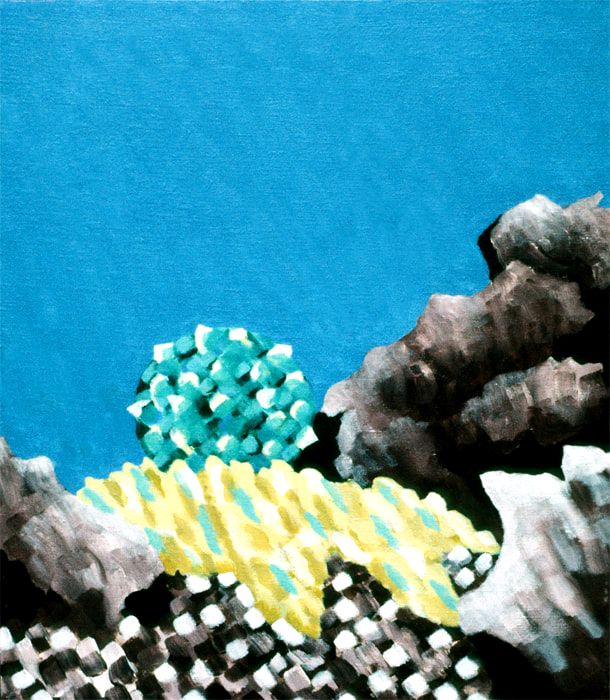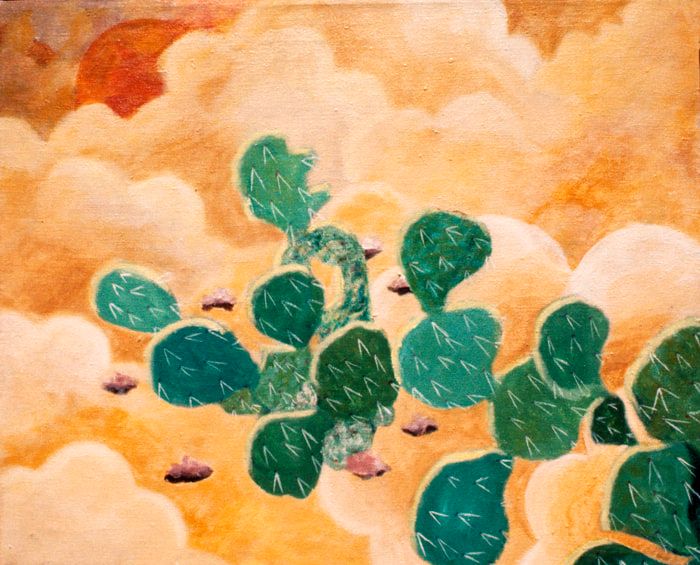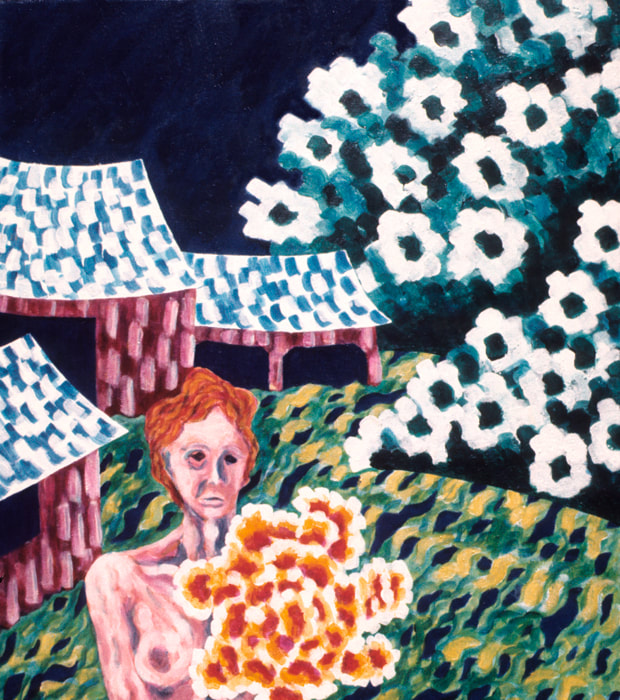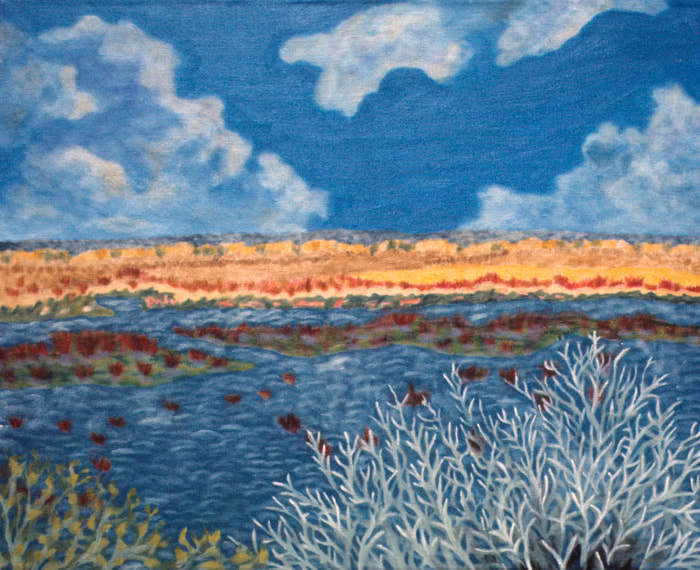|
I was on the way to help a friend install an art exhibit in the city. I stopped at another friend's house in Riverhead who was having a party. I left but stopped to call NY since I was running a little late. The installation was postponed until the next day. I returned to the party. When I left, Mel came with me back to the loft in Greenport. She really liked “The Hand of Man,” which I was just completing. Soon we bought a used bed to complement the metal patio table with a hole in the middle, the wooden folding chairs from the Odd Fellows, and a small 3 drawer dresser. A month or so later I was walking home from work when several workers from Preston's Marine Supplies blocked my way. They asked if my intentions were honorable. Mel's family was well known. I gave them a firm “YES.” Mel and I have been married for 46 years at the end of this month.
This time I got a job through a friend with a dock builder in Greenport, Long Island. We had a tow boat and a barge with a crane on it for setting piles. I found a loft to rent which had been a sail makers loft, then an Odd Fellows hall. The building was cracked in the corner and you could see the street below. I added a shower stall in the kitchen. The main room was 30' x 40' with no posts. I worked during the day and painted at night and on the weekends. People asked me if the man in “Man Running” was running from or running to something. I said he was just running.
The Headstart program ended. I had met the owner of Greenfield Gallery. In exchange for a painting I had the use of a studio in a house he owned being refurbished. “Cactus and Grass” was the focused result. He also owned a business school. I wrote a speed writing course for Spanish for his school which was still in use years later. With my earnings from Headstart and the course, I purchased my aunt's van, put the lawn chair mattress in the back, and returned to NYC.
When it became apparent that there would be no sale at the Dorsky, it was stuck in cactus heaven again. I got a job as the director of the San Elizario Head Start program. I gathered the local parents to refurbish the salon in the church I had previously painted. I furnished the beer, the people furnished the rest. It was beautiful when done. With percussion instruments for kindergartners we made a rhythm orchestra. The noise was heavenly.
I was accepted for a group show at a respectable NY gallery. The gallery director said that I needed a larger work. I anchored a 48” x 62” canvas on a studio easel and at the end of the day returned the house with a background and the figures roughed in. The were friends. I delivered “The Bathers”, “Gates of Eden”, and the newly finished “The Couple” to the gallery. My time was up. I had to return the borrowed van to Texas and vacate the loaned house. I was a sale away from a plane ticket back to NYC.
A mentor, Mike Lekakis, asked me if I was afraid of straight lines. The horizon in 'The Bathers' is a straight line. I kept it from cutting off the canvas with a bridging pattern. The beaches on the Long Island Sound are pebbles. They look like eggs. The whole thing is very sensual. The ocean is all about reproduction.
If you think about it, nature doesn't have any hard edges. There are clusters where something is dominate, but always there is something else in the mix. I emphasized that in Edge of the Field. I started this outside and finished it several days later inside. It's painted with multiple glazes.
I was warmly welcomed by my friends in NY. I sold several paintings. I painted “Untitled” the first couple of days while I couch surfed. I traded a painting and a promise to paint the kitchen for a few months in a summer house on the north fork of Long Island. While there I traveled back and forth seeking representation in the city.
Woodstock Belle, my last painting before leaving, was painted over several days in my parents garage. My aunt, retired and living close to her sister, my mother, wholeheartedly supported my art. With winter coming she lent me her panel van to transport my paintings to New York. I was to return the van. With the paintings tied to the van walls and a lawn furniture cushion for a bed, I was off to NYC again.
Once again I climbed into the mountains, chose my composition, and began. I put more detail into the foregound which took more time. I pushed well into dusk before I started back down to the car. I slipped and rolled about thirty feet down the slope through the cactus. I was unhurt except I had to take off my jacket and trousers to remove the cactus spines. That was the only time I stayed too late.
The city of El Paso, Texas, wraps around the Franklin Mountains like a “U”. At the edge of the suburbs against the mountain I parked my parent's car and climbed up the over 3,000 ft. high mountain with my portable easel, paints, water, lunch, and a blank canvas. Within a few hundred feet, over a ridge, it is suddenly silent. The city has vanished. I use my fingers to form a rectangle and choose my composition, set up my easel, and begin. I have until dusk to finish. I need light to climb back down.
Some cemeteries in El Paso were watered grass. This cemetery in Ysleta, Texas, a small Mexican American town which predates El Paso, was all natural and dry except for the plastic flowers on the graves. Real flowers wouldn't have lasted a day in the summer heat.
When the pioneers first came to the Rio Grande valley at El Paso they say the grass was stirrup high. To protect their cattle the cattlemen killed the prairie dogs which stirred the soil. It just then got dryer and dryer. The grass is long gone. This old structure was shade for a shepherd. I left out the thruway in the background.
In the fall everything in the valley turned orange. This edge of a cultivated field lent itself to an explosion design. The light at the end of the day made everything shiny.
Away from the cultivated Rio Grande valley, a depression in the desert can collect the very occasional rain with stunning results.
A few miles southeast of San Elizario is a border crossing into Mexico at San Isidro. I took that crossing, turned right, and within a mile or so I saw a lake in the desert. I sat up my easel and began to paint. In a few minutes a Mexican policeman approached and demanded to know what I was doing there. The lake was a lagoon for the municipal sewege plant for Juarez. I spoke Spanish. He said his uncle was a painter. We had a nice discussion about art. He went on his way, and I resumed painting.
I took an early morning bus to San Elizario, a small Hispanic community on the border 35 miles south of El Paso. With a prepared canvas, paints, water, food, and a portable easel, I selected a scene for the day and painted the canvas. This was the church on the square built in the late 1800's for the Catholic soldiers protecting the border. It was traditional, constructed of adobe with thick walls and high ceilings.
This was the last Woodstock landscape. The frame shop closed. I returned to live with my parents in El Paso, Texas. My missing front tooth was replaced. I left NYC and went to Woodstock to work in Mike's frame shop in 1969. I was enthralled by the beauty of New England. “Landscape with Yellow Field” was painted outside in a day, Van Gogh style. Prepare the canvas the night before. Get on site early in the morning when the light is cool. Paint all day. By the end the light is yellow and the shadows are reversed. Much has happened.
I visited Mike and his wife, Carol, and child, Little Mike, on the weekends. This was the edge of his yard.
Mike Denson made the frames at Henry Rothman's frame shop where I was the fitter in '68. Mike moved to Woodstock, NY, and started a frame shop. The painting “Mike Denson's Place” records a memorable acid trip weekend. I'm about to fall into the brook. The artist Mike Lekakis, a mentor, said I had found my style.
Ngoot Lee, a traditional Chinese painter, lived in the top floor loft above HR's frame shop. He invited me and my friend Bob Day for dinner. We ate thousand year old bird's nest soup, and I marveled at a scroll of birds he had painted while on vacation in the Hamptons. As an artist I am largely self taught. My maternal aunt gave me an art book of Chinese paintings. I was fascinated by the brushwork and the lack of traditional perspective. I copied this work by Wang Meng from the fourteenth century. What a lesson that was.
I was against the war and protested in Central Park, 1968, NYC. I remember running from the police. I remember. A friend, photographer, and I rented the top floor loft in the old Klein's department store at Fourteenth and Broadway, NYC, in 1968. We ate at the Central Cafe on the corner. Take out orders were “seaboard”. The painting “Central Seaboard” is a self portrait. There are two customers, three waiters, and myself walking the walls into the future. |

























 RSS Feed
RSS Feed